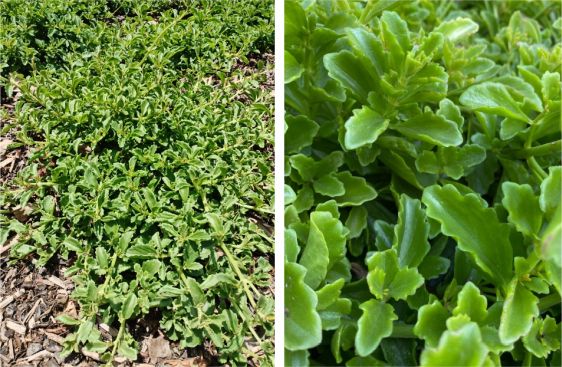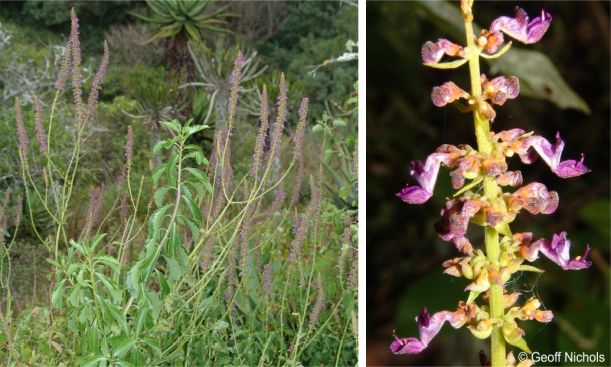Coleus subspicatus
Coleus subspicatus (Hochst.) Walp. (= Plectranthus spicatus E.Mey. ex Benth.)
Family: Lamiaceae
Common names: spike spurflower, long-spiked spurflower, lavender spurflower (Eng.); ritsblom spoorsalie (Afr.)
Introduction
Coleus subspicatus is a versatile, attractive and resilient plant that offers both aesthetic appeal and everyday garden benefits, that has become a popular choice for gardeners looking to add a touch of beauty to their outdoor spaces with low maintenance requirements. It is often grown for its eye-catching foliage that also has a distinctive pungent fragrance when crushed, as well as its colourful late summer blooms that come in several shapes and colours, from white and pink to dark mauve and purple. It is a tough ground cover that does well in dry conditions and grows in both sun and semi-shade, which certainly makes it a good plant choice to brighten up any garden scenery. The scientific name of this species was recently changed to Coleus subspicatus and it is still better known under its old name Plectranthus spicatus.

Description
Description
A much-branched succulent groundcover with a shallow root system and slender, 4-angled stems, that grows up to about 700 mm in height. The spike spurflower has bright dark green, oblong leaves that have distinctive serrated edges and a slightly imprecise texture, adding to the plant's visual appeal. In late summer to early autumn (March-June), the plant produces 80-300 mm long and 15-30 mm wide spike-like flowerheads made up of many small cylindrical flowers in shades of white, pink, or purple, attracting pollinators such as bees and butterflies to the garden. The buds have crab-like claws on the tips and take a while to open. The calyx changes in shape as it matures, whereby in the flowering period it is horizontal and straight with the upper tooth larger than the other 4 teeth. When it is in fruit, the tube curves upwards, becoming swollen at the base, and all 5 teeth become erect with the top only somewhat larger than the rest.

Conservation Status
Status
According to the Red List of South African plants, Coleus subspicatus is considered not threatened and is assessed as Least Concern (LC).
Distribution and habitat
Distribution description
The natural distribution range of Coleus subspicatus is from the coast up into the Drakensberg foothills, from the Humansdorp District the Eastern Cape, through KwaZulu-Natal and into Mpumalanga in the north. It also occurs in Eswatini and southern Mozambique. Its natural habitat is the dry to semi-arid savannah or bushveld, on rocky ridges, in both hot sun and light shade. Rainfall occurs mainly in summer and frost is absent or light.
Derivation of name and historical aspects
History
This species belongs to the Lamiaceae, a family which includes several groups of fragrant plants that hold valuable biologically effective compounds. It was previously placed in the genus Plectranthus but was moved into the genus Coleus after DNA studies indicated that the species that were thought to belong in Plectranthus do not all share the same common ancestor. As a result the genus Plectranthus was redefined and the genus Coleus was re-instated and many species formerly recognized as belonging in Plectranthus were moved into Coleus. The genera Plectranthus and Coleus are abundant and widely used in southern Africa. The diversity of these genera is a notable element of the biodiversity of Africa. They make a horticulturally important group of largely herbaceous plants that are becoming increasingly popular in indigenous landscaping in South Africa. Some species are appropriate as shrubs or may be pruned into hedges, some like Coleus subspicatus make good groundcovers, some make good subjects for rock gardens and succulent gardens, and several other species grow well in large containers, pots and hanging baskets.
The species name subspicatus means ‘almost spiked’, and comes from the Latin words sub, meaning ‘below’, almost’ or ‘approaching’, and spica, which means ‘spike’, referring to the spike-like inflorescence. Gardeners familiar with this plant species, know it as the spike spurflower, or lavender spurflower, which is more descriptive of its attractions.

Ecology
Ecology
The flowers of the spike spurflower are a favourite among pollinators like bees and butterflies, and plants are hosts for the larval phase of the Gaudy Commodore butterfly, making it a valuable addition to any garden that aims to support local wildlife. By planting Coleus subspicatus, gardeners can help to create a more biodiverse and resilient ecosystem in their own backyard. The plant's capability to resist unwanted insects and rodents is recognized, leading to it being used as a natural pest control agent in certain areas.
Uses
Use
Although there are no records of medicinal or cultural uses for Coleus subspicatus, many plants in the genus Coleus are used as traditional medicines to treat a range of sicknesses, including chest, stomach and skin complaints and skin irritations. The essential oils extracted from the plants show anti-allergic, antibacterial, antifungal, and anti-inflammatory properties, making them a common component in making herbal mixtures. Some species are used as food, or to flavour food, or as feed for stock animals.
In gardens, Coleus subspicatus is used as a vigorous ground cover and has been found appropriate as a green-roof plant. One can grow it as a succulent groundcover for rock gardens, slopes, or can be planted around Aloe species or any other large succulents. It can also be grown as a potted plant where it develops a denser growth habit. However, one needs to be watchful, as it grows rapidly and has the capacity to overpower or suppress less vigorous, smaller plants.

Growing Coleus subspicatus
Grow
It can be easily grown from cuttings. Plant it in a rich, well-composted garden soil that drains well. Water it regularly during hot and dry spells. Prune the plant after flowering to stimulate new growth and preserve its appearance. It is a low maintenance plant ideal for beginners or developed gardens and pests and diseases are generally not a major issue with this species.
When growing the species, one must be cautious when grouping it with other plants by making sure that it is grouped with plants of a similar growth habit as it tends to suppress other smaller and less robust plants.
The species is drought-resistant and should be planted with other drought-resistant species. Even though the species will survive frost when planted in a protected area, if not, in winter, it will be cut back to ground by frost and should be mulched to protect the roots, so the plant survives and resprouts in spring.
Coleus subspicatus does well in semi-shaded to sunny areas and will need more watering when grown in a sunnier position but one needs to be careful not to overwater it as leaves can be shed prematurely when overwatered. Remove the spent flower spikes regularly to extend flowering and prune lightly when they have finished flowering. The growing shoots can be pinched out regularly during summer season to promote more compact growth.
Avoid fertilizing while the plants are in flower. Apply a 2:3:2 or 3:1:5 granular or liquid fertilisers to feed the plant in spring and early summer, followed by proper watering, to avoid burning the tender roots.
References
- Bhatt, A., Naidoo, Y. & Nicholas, A. 2010. The foliar trichomes of Plectranthus laxiflorus Benth (Lamiaceae): an important medicinal plant. New Zealand Journal of Botany 48(2): 55-61.
- Brits G..J, Selchau, J. & Van Deuren, G. 2001. Indigenous Plectranthus (Lamiaceae) from South Africa as new flowering pot plants. Acta Horticulturae 552: 165-170.
- Brits, G. & Li, L. 2008. Polyploid breeding of wild South African Plectranthus (Spurflowers) as new flowering pot plants. Acta Horticulturae 774: 437-442.
- Codd, L.E. 1985. Plectranthus (Lamiaceae). Flora of Southern Africa 28: 137-172.
- Dellar, J.E., Cole, M.D. & Waterman, P.G. Antimicrobial abietane diterpenoids from Plectranthus elegans. Phytochemistry 41(3): 735-738.
- Ecoman, Environmental Landscape Design Specialist. Plectranthus spicatus. https://ecoman.co.za/green/green_docs/plectranthus_spicatus.html. Accessed on 2024/06/25.
- NEW POSA, Plants of southern Africa. Species search: Plectranthus spicatus. https://posa.sanbi.org/sanbi/Explore. Accessed on 2024/06/25.
- Notten, A.L. 2020. Coleus Lour. (Lamiaceae). PlantZAfrica. Online. http://pza.sanbi.org/coleus-genus.
- Paton, A.J., Mwanyambo, M., Govaerts, R.H.A., Smitha, K., Suddee, S., Phillipson, P.B., Wilson, T.C., Forster, P. I. & Culham, A. 2019. Coleus and Plectranthus (Lamiaceae): a tale of more than two genera. Phytokeys 129: 1–158.
- Pooley, E. 1998. A field guide to wild flowers of Kwazulu-Natal and the eastern region. Natal Flora Publications Trust, Durban.
- Raimondo, D., Von Staden, L., Foden, W., Victor, J.E., Helme, N.A., Turner, R.C., Kamundi, D.A. & Manyama, P.A. (eds) 2009. Red list of South African plants. Strelitzia 25. South African National Biodiversity Institute, Pretoria.
- The Indigenous Gardener. Plectranthus spicatus. https://www.theplantlibrary.co.za/plants/plectranthus-spicatus. Accessed on 2024/06/25.
- Timberlake, J.R. & Martins, E.S. 2013. Flora Zambesiaca. Royal Botanic Gardens, North America.
- Van Jaarsveld, E. 2006. The southern African Plectranthus and the art of turning shade to glade. Fernwood Press, Vlaeberg, Cape Town.
Credits
Sihle Nqentsu
Pretoria National Botanical Garden
July 2024
Acknowledgements: additional images by Geoff Nichols.
Plant Attributes:
Plant Type: Ground Cover, Perennial
SA Distribution: Eastern Cape, KwaZulu-Natal, Mpumalanga
Soil type: Sandy, Clay, Loam
Flowering season: Late Summer, Autumn
PH:
Flower colour: Purple, White, Pink
Aspect: Full Sun, Morning Sun (Semi Shade), Afternoon Sun (Semi Shade)
Gardening skill: Easy
Special Features:
Horticultural zones









Rate this article
Article well written and informative
Rate this plant
Is this an interesting plant?
Login to add your Comment
Back to topNot registered yet? Click here to register.